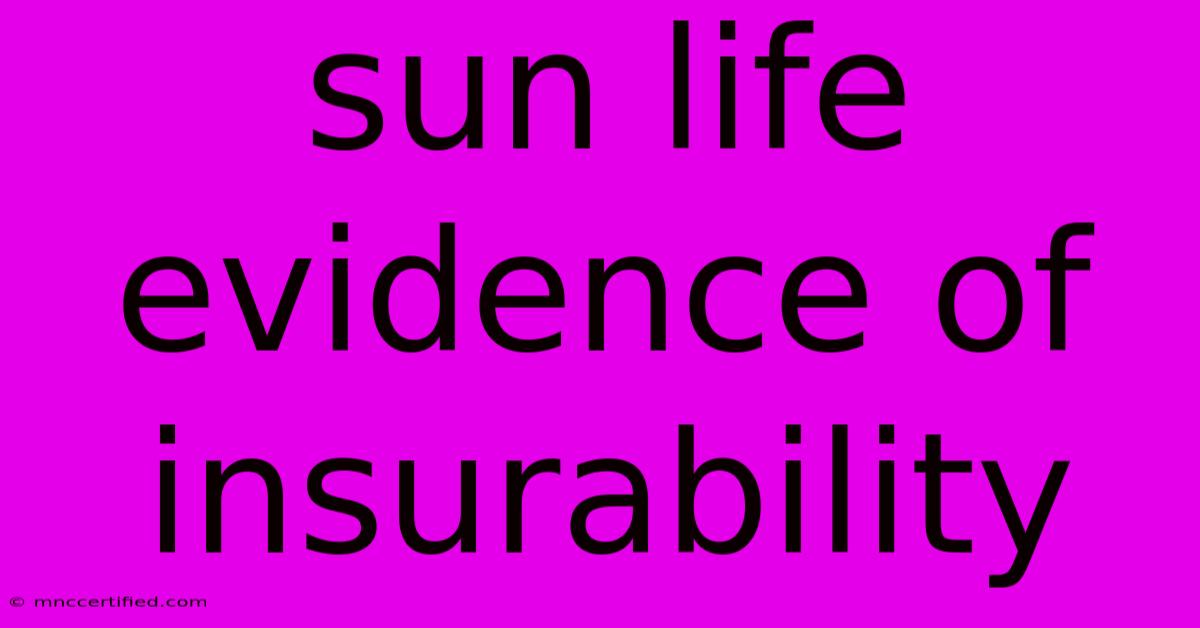Sun Life Evidence Of Insurability

Table of Contents
Sun Life Evidence of Insurability: A Comprehensive Guide
Applying for life insurance can feel overwhelming, especially when faced with the term "evidence of insurability." This guide breaks down Sun Life's evidence of insurability requirements, helping you navigate the process smoothly. Understanding this crucial step will significantly improve your chances of securing the coverage you need.
What is Evidence of Insurability (EOI)?
Evidence of insurability is the process Sun Life uses to assess your health and risk profile before issuing a life insurance policy. It's essentially a health check to determine your eligibility and the premium rate you'll pay. The more information Sun Life has, the better they can assess your risk and offer you the most appropriate coverage. Think of it as a necessary step to ensure fair pricing and responsible underwriting.
When is EOI Required?
Sun Life may require EOI in several situations:
- Increasing your coverage amount: If you want to increase your existing policy's death benefit, you'll likely need to provide updated EOI.
- Adding beneficiaries: While not always required, adding beneficiaries might trigger an EOI request, especially if the additional coverage is substantial.
- Applying for a new policy: This is the most common scenario where EOI is needed. Sun Life needs to evaluate your health to determine your risk profile and assign an appropriate premium.
- Policy reinstatement: If your policy lapsed and you're trying to reinstate it, EOI will likely be required.
What Does Sun Life's EOI Process Involve?
The specifics of Sun Life's EOI process can vary depending on the policy type and the amount of coverage you're seeking. However, it generally involves these steps:
- Application Completion: You'll begin by completing a detailed application, providing information about your health history, lifestyle, and family medical history. Be thorough and accurate in this stage; inaccuracies can delay or even jeopardize your application.
- Medical Questionnaire: This comprehensive questionnaire delves deeper into your health, asking about pre-existing conditions, medications, hospitalizations, and surgeries. Accurate answers are crucial.
- Paramedical Exam (Sometimes Required): Depending on your health history and the amount of coverage requested, Sun Life might require a paramedical exam. This involves a nurse or technician taking your blood pressure, height, weight, and blood sample. Sometimes, an electrocardiogram (ECG) might also be necessary. This step helps Sun Life gain a clearer picture of your current health status.
- Review and Decision: Once Sun Life receives all necessary information, they will review your application and make a decision regarding your eligibility and premium rate.
Tips for a Smooth EOI Process:
- Be Honest and Accurate: Providing false information can lead to policy denial or even legal consequences.
- Gather Necessary Information: Before starting the application, gather all relevant medical records, including doctor's reports and medication lists.
- Contact Sun Life Directly: If you have questions or concerns about the EOI process, contact Sun Life directly to clarify any uncertainties. They can provide personalized guidance based on your specific situation.
- Understand the Timeline: Be aware that the EOI process takes time. Allow ample time for the completion of questionnaires, medical exams (if required), and the review process.
Understanding Your Options
If you're concerned about the EOI process, remember that Sun Life offers various life insurance products. Some policies might have simplified underwriting or no medical exam requirements, potentially reducing the burden of providing extensive EOI. Discussing your needs and concerns with a Sun Life representative can help you choose a policy that suits your individual circumstances.
Remember, securing life insurance is a crucial step in financial planning. By understanding the Sun Life EOI process and preparing thoroughly, you can navigate it confidently and protect your loved ones' financial future.

Thank you for visiting our website wich cover about Sun Life Evidence Of Insurability. We hope the information provided has been useful to you. Feel free to contact us if you have any questions or need further assistance. See you next time and dont miss to bookmark.
Featured Posts
-
Trump Nominates Brendan Carr For Fcc Chair
Nov 19, 2024
-
Starmer Budget Not To Blame For Mortgage Costs
Nov 19, 2024
-
Homeowners Insurance For Teachers
Nov 19, 2024
-
Best Kc Chiefs Gifts This Holiday
Nov 19, 2024
-
Who Normally Pays Title Insurance
Nov 19, 2024